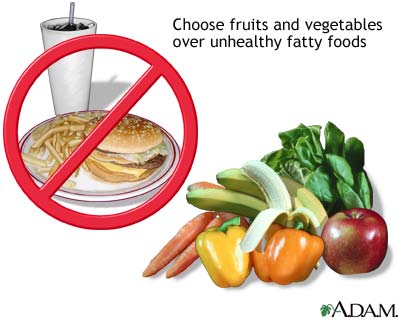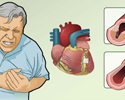Angina - discharge
Chest pain - discharge; Stable angina - discharge; Chronic angina - discharge; Variant angina - discharge; Angina pectoris - discharge; Accelerating angina - discharge; New-onset angina - discharge; Angina-unstable - discharge; Progressive angina - discharge; Angina-stable - discharge; Angina-chronic - discharge; Angina-variant - discharge; Prinzmetal angina - discharge
Angina is a type of chest discomfort due to poor blood flow through the blood vessels of the heart muscle. This article discusses how to care for yourself when you leave the hospital.
When You're in the Hospital
You were having angina. Angina is chest pain, chest pressure, often associated with shortness of breath. You had this problem when your heart was not getting enough blood and oxygen. You may not have had a heart attack.
What to Expect at Home
You may feel sad. You may feel anxious and that you have to be very careful about what you do. All of these feelings are normal. They go away for most people after 2 or 3 weeks.
You may also feel tired when you leave the hospital. You should feel better and have more energy 5 weeks after you are discharged from the hospital.
Activity
Know the signs and symptoms of angina:
- You may feel pressure, squeezing, burning, or tightness in your chest. You may also have pressure, squeezing, burning, or tightness in your arms, shoulders, neck, jaw, throat, or back.
- Some people may feel discomfort in their back, shoulders, and stomach area.
- You may have indigestion or feel sick to your stomach. You may feel tired and be short of breath, sweaty, lightheaded, or weak. You may have these symptoms during physical activity, such as climbing stairs, walking uphill, lifting, and engaging in sexual activity.
- You may have symptoms more often in cold weather. You can also have symptoms when you are resting, or when wake you up from your sleep.
Ask your health care provider how to treat your chest pain when it happens.
Chest pain
Acute coronary syndrome - chest pain; Coronary artery disease - chest pain; CAD - chest pain; Coronary heart disease - chest pain; ACS - chest pain; ...
Take it easy at first. You should be able to talk easily when you are doing any activity. If you cannot, stop the activity.
Ask your provider about returning to work. You may need to work less, at least for a while. If heavy lifting or hard manual labor is part of your job, you may need to change the kind of work you do.
Your provider may refer you to a cardiac rehabilitation program. This will help you learn how to slowly increase your exercise. You will also learn how to take care of your heart disease .
Take care of your heart disease
Heart attack - activity; MI - activity; Myocardial infarction - activity; Caridiac rehabilitation - activity; ACS - activity; NSTEMI - activity; Acut...

Diet and lifestyle
Try to limit how much alcohol you drink. Ask your provider when it is OK to drink, and how much is safe.
DO NOT smoke cigarettes. If you do smoke, ask your provider for help quitting. DO NOT let anyone smoke in your home.
Learn more about what you should eat for a healthier heart and blood vessels. Avoid salty and fatty foods. Stay away from fast-food restaurants. Your provider can refer you to a dietitian, who can help you plan a healthy diet.
Healthier heart
Hyperlipidemia - cholesterol and lifestyle; CAD - cholesterol and lifestyle; Coronary artery disease - cholesterol and lifestyle; Heart disease - cho...

Try to avoid stressful situations. If you feel stressed or sad, tell your provider. They can refer you to a counselor.
Ask your provider about sexual activity. Men should not take medicines or any herbal supplements for erection problems without checking with their provider first. These drugs are not safe when used with nitroglycerin.
Taking your heart drugs
Have all of your prescriptions filled before you go home. You should take your drugs the way you have been told. Ask your provider if you can still take other prescription drugs, herbs, or supplements you have been taking.
Take your drugs with water or juice. DO NOT drink grapefruit juice (or eat grapefruit), since these foods may change how your body absorbs certain medicines. Ask your provider or pharmacist about this.
People who have angina often receive the drugs below. But sometimes these drugs may not be safe to take. Talk with your provider if you are not already taking one of these drugs:
-
Antiplatelet drugs (blood thinners), such as
aspirin
,
clopidogrel
(Plavix), prasugrel (Efient), or ticagrelor (Brilinta)
Aspirin
Blood thinners - aspirin; Antiplatelet therapy - aspirin
 ImageRead Article Now Book Mark Article
ImageRead Article Now Book Mark ArticleClopidogrel
Blood thinners - clopidogrel; Antiplatelet therapy - clopidogrel; Thienopyridines
 ImageRead Article Now Book Mark Article
ImageRead Article Now Book Mark Article -
Other medicines, such as
warfarin
(Coumadin), to help keep your blood from clotting
Warfarin
Warfarin is a medicine that makes your blood less likely to form clots. This may be important if:You have already had blood clots in your leg, arm, ...
Read Article Now Book Mark Article - Beta-blockers and ACE inhibitor medicines, to help protect your heart
-
Statins or other drugs to lower your cholesterol
Statins or other drugs to lower your ch...
Hyperlipidemia - drug treatment; Hardening of the arteries - statin
 ImageRead Article Now Book Mark Article
ImageRead Article Now Book Mark Article
Never just stop taking any of these drugs. DO NOT stop taking any other drugs you may be taking for diabetes, high blood pressure, or any other medical problems.
If you are taking a blood thinner, you may need to have extra blood tests to make sure your dose is correct.
When to Call the Doctor
Call your provider if you feel:
- Pain, pressure, tightness, or heaviness in the chest, arm, neck, or jaw
- Shortness of breath
- Gas pains or indigestion
- Numbness in your arms
- Sweaty, or if you lose color
- Lightheaded
Changes in your angina may mean your heart disease is getting worse. Call your provider if your angina:
- Becomes stronger
- Occurs more often
- Lasts longer
- Occurs when you are not active or when you are resting
- If drugs do not help ease your angina symptoms as well as they used to
References
Amsterdam EA, Wenger NK, Brindis RG, et al. 2014 AHA/ACC guideline for the management of patients with non-ST-elevation acute coronary syndromes: a report of the American College of Cardiology/American Heart Association Task Force on Practice Guidelines. J Am Coll Cardiol . 2014;64(24):e139-e228. PMID: 25260718 www.ncbi.nlm.nih.gov/pubmed/25260718 .
Fihn SD, Gardin JM, Abrams J, et al. 2012 ACCF/AHA/ACP/AATS/PCNA/SCAI/STS guideline for the diagnosis and management of patients with stable ischemic heart disease: a report of the American College of Cardiology Foundation/American Heart Association task force on practice guidelines, and the American College of Physicians, American Association for Thoracic Surgery, Preventive Cardiovascular Nurses Association, Society for Cardiovascular Angiography and Interventions, and Society of Thoracic Surgeons. Circulation . 2012;126(25):e354-e471. PMID: 23166211 www.ncbi.nlm.nih.gov/pubmed/23166211 .
O'Gara PT, Kushner FG, Ascheim DD, et al. 2013 ACCF/AHA guideline for the management of ST-elevation myocardial infarction: executive summary: a report of the American College of Cardiology Foundation/American Heart Association Task Force on Practice Guidelines. Circulation . 2013;127(4):529-555. PMID: 23247303 www.ncbi.nlm.nih.gov/pubmed/23247303 .
Sabatine M, Cannon CP. Approach to the patient with chest pain. In: Mann DL, Zipes DP, Libby P, Bonow RO, Braunwald E, eds. Braunwald's Heart Disease: A Textbook of Cardiovascular Medicine . 10th ed. Philadelphia, PA: Elsevier Saunders; 2015:chap 50.
-
Chest pain
Animation
-
Angina causes and symptoms
Animation
-
Healthy diet - illustration
For a healthy diet, replace unhealthy and fattening foods with healthier alternatives, such as fresh fruits and vegetables.
Healthy diet
illustration
Review Date: 8/2/2016
Reviewed By: Michael A. Chen, MD, PhD, Associate Professor of Medicine, Division of Cardiology, Harborview Medical Center, University of Washington Medical School, Seattle, WA. Also reviewed by David Zieve, MD, MHA, Isla Ogilvie, PhD, and the A.D.A.M. Editorial team.




